Falling fertiliser prices may have taken some of the sheen off clover, but it remains the only show in town to reduce greenhouse gas emissions from agriculture without reducing agricultural output. Clover has its challenges – it’s difficult to establish and difficult to persist in the sward, has low tolerance for poor soil fertility and doesn’t really like wet soils.
However, farmers that ignore clover are ignoring income potential today and perhaps their licence to farm in the future. So, what are the key things to work on in order to get clover established across the farm?
1. Go all out
Having just one or two paddocks of clover is neither here nor there and can actually cause more problems in terms of bloat because cows aren’t adjusted to eating clover.
Teagasc has come up with a four-year plan for getting clover established across a farm that has no clover to begin with. This involves reseeding 10% of the farm per year and oversowing clover across a further 15% of the farm, thereby establishing clover across 25% of the farm per year. It is not all going to work and oversowing is weather dependent but it will take too long to get clover established if oversowing is not carried out.
2. Where to start?
There are a couple of provisos when it comes to clover establishment.
Firstly, soil fertility must be good regardless of whether the method is oversowing or full reseed. Even where clover is not being established, reseeding a field with poor soil fertility is not good practice as perennial ryegrass needs good soil fertility to persist. With clover, soil pH is key and the requirement is pH 6.5 which is higher than the target for grass.
The advice is clear, if soil fertility is low, fix that first before trying to get clover established. That means spreading lime the year before clover is to be established.
Presuming soil fertility is good, fields for oversowing clover should have good perennial ryegrass content in the sward. These fields will be more open and have a better chance of clover getting established. It also means that the field doesn’t need to be reseeded for at least the next six or seven years. For full reseeds, choose fields that are performing poorly, have low perennial ryegrass content or high weed burdens as reseeding these fields will increase grass growth on the farm.
3. Oversowing
Having chosen the field, the next decisions are around timing and method of oversowing. In terms of timing, the window of opportunity is running out soon. Certainly, any oversowing should be completed by mid-May as going any later increases the prospect of a dry spell affecting the clover seedlings. Therefore, the earlier the seeds are in the better and the Teagasc advice is geared more towards April rather than May.
Oversow as soon as possible after a field is grazed. The objective is to get the clover seed in contact with soil. The clover seed doesn’t need to be buried but it does need contact with the soil and ideally to be pressed into the soil.
This brings us to method.
There are a variety of options here ranging from broadcasting with fertiliser, slot seeding using a Moore or Erth seeder or sowing with a tine drill and air seeder such as Einbock or tine drill and roller such as a Guttler.
4. Fertiliser spreader
Sowing seed with fertiliser is probably the cheapest method for most farmers that have their own fertiliser spreader. The seed should be mixed with zero N fertiliser out in the paddock such as 0:7:30 or 0:10:20 or granulated lime and no more than 1ha should be sown at any one time. The risk by doing more is that the seed will settle in the spreader and not go out evenly.
Clover will not travel far so the spreading width should be reduced to 5ft between bouts.
Because the seed will be sitting on the surface in both this method and with an Einbock machine soiled water should be spread after sowing using a splashplate which will help to press the seed into the soil and improve seed to soil contact.
5. Post oversowing
All of the above mentioned sowing methods achieve good results provided the conditions are right and the post-sowing management is appropriate.
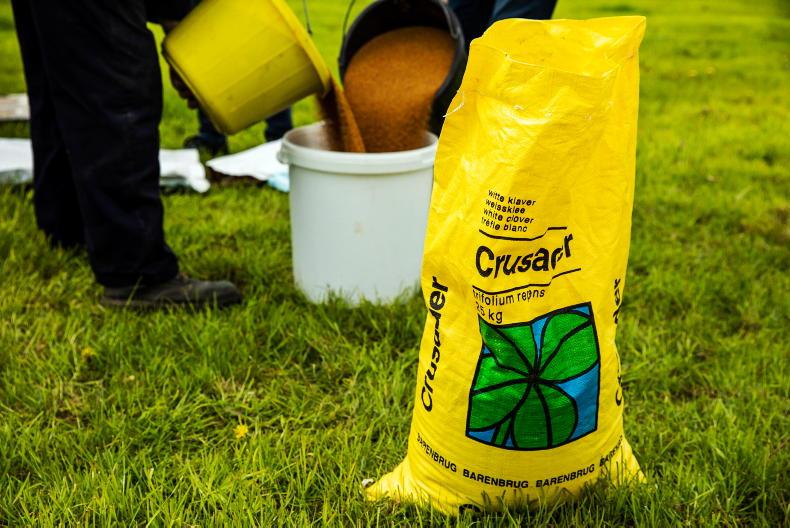
Clover seed should be measured out in the field and then mixed with fertiliser. \ Philip Doyle
A half-hearted approach to management of oversown swards will not work. This is easier said than done because there are lots of distractions at this time of year. In general, germination will not be a problem and this can give a false sense of certainty that the farmer’s job is done just because the clover is up. However, keeping these seedlings alive is a tough, but important, job.
The advice is to keep light to the base of the swards.
The main cause of seedling death is not being trampled on, but a lack of light and therefore tight grazing at low covers will maximise light to the base of the sward and ensure the seedlings survival. This means grazing these oversown paddocks at covers of 800kg to 1,000kg DM/ha which effectively means grazing every 16 days rather than every 21 days.
The best policy is to write this up on a calendar in the dairy or put a notification in the phone to remind the farmers that the paddocks need to be grazed.
Managing any more than two paddocks in this way is difficult. It also means that paddocks which the cows are due to go into next, and which are just about perfect for grazing are left for a day or two while the cows are grazing the clover fields – meaning they could be too strong by the time the cows actually get to them.
6. Fertiliser
Reducing the amount of fertiliser on oversown paddocks helps to reduce grass growth which in turn helps to prevent the clover from being shaded out.
The advice is to cut back nitrogen for six to eight weeks after oversowing for this reason. Teagasc says that the clover won’t be fixing nitrogen until the following year so normal rates apply after the initial oversowing period.
In a full reseed, there is usually a large release of mineralised nitrogen from the soil and this acts as a source of nitrogen for the grass and young clover seedlings. A high proportion of this nitrogen is also subject to leaching, hence min-till techniques are required from June onwards under nitrates rules.
7. Spraying
Post-emergence weed control is essential in new reseeds. The advice now is to spray for weeds at the six-week stage post sowing with a clover safe herbicide. This means that the seedling docks will be killed at the correct stage and the clover will be strong enough to withstand the effects of the spray.
Delaying spraying until all clover plants are at the three-week trifoliate stage usually means docks are gone too strong and will be harder to kill.
8. Prevent bloat
Clover contents need to be managed to help prevent bloat.
The cow also needs to be managed but this is easier when clover contents don’t go too high. Too high is anything above 40% clover in autumn.
One of the ways of preventing this is to ensure that grass content is maintained by applying nitrogen in spring, when clover isn’t fixing additional nitrogen.
Ryegrass is a nitrogen hungry plant and needs a drip feed of nitrogen. Zero nitrogen systems tend to see lower ryegrass contents and higher clover contents in the autumn, which can lead to bloat and also poor pasture supply in spring.
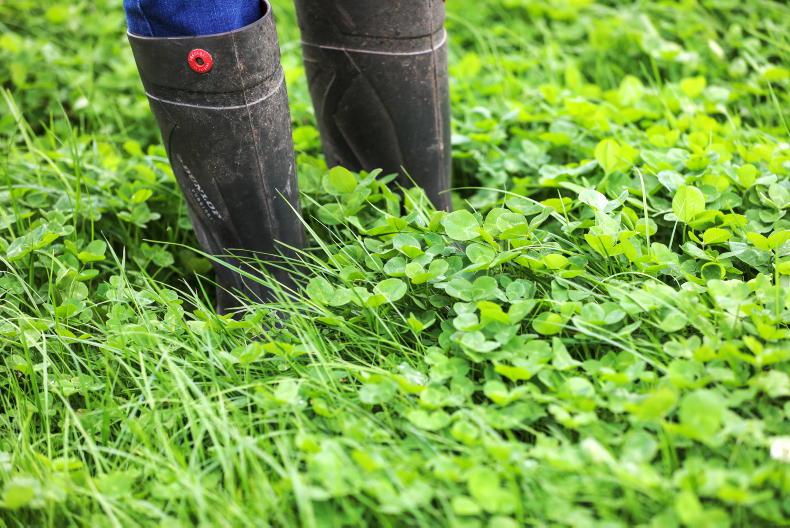
Clover contents should be managed to prevent bloat. \ Odhran Ducie
The Teagasc advice for bloat prevention is to be consistent with regard to grazing clover and non-clover paddocks, use a strip wire to allocate pasture, use bloat oil in high risk periods, let all cows out to the paddock together to prevent those milked first from gorging and to target fibre in the diet.
Clover remains the only show in town to reduce greenhouse gas emissions from agriculture without reducing agricultural output.Success of oversowing is weather dependent but it will take too long to get clover established if oversowing is not carried out.Reducing the amount of fertiliser on oversown paddocks helps to reduce grass growth which in turn helps to prevent the clover from being shaded out.
Falling fertiliser prices may have taken some of the sheen off clover, but it remains the only show in town to reduce greenhouse gas emissions from agriculture without reducing agricultural output. Clover has its challenges – it’s difficult to establish and difficult to persist in the sward, has low tolerance for poor soil fertility and doesn’t really like wet soils.
However, farmers that ignore clover are ignoring income potential today and perhaps their licence to farm in the future. So, what are the key things to work on in order to get clover established across the farm?
1. Go all out
Having just one or two paddocks of clover is neither here nor there and can actually cause more problems in terms of bloat because cows aren’t adjusted to eating clover.
Teagasc has come up with a four-year plan for getting clover established across a farm that has no clover to begin with. This involves reseeding 10% of the farm per year and oversowing clover across a further 15% of the farm, thereby establishing clover across 25% of the farm per year. It is not all going to work and oversowing is weather dependent but it will take too long to get clover established if oversowing is not carried out.
2. Where to start?
There are a couple of provisos when it comes to clover establishment.
Firstly, soil fertility must be good regardless of whether the method is oversowing or full reseed. Even where clover is not being established, reseeding a field with poor soil fertility is not good practice as perennial ryegrass needs good soil fertility to persist. With clover, soil pH is key and the requirement is pH 6.5 which is higher than the target for grass.
The advice is clear, if soil fertility is low, fix that first before trying to get clover established. That means spreading lime the year before clover is to be established.
Presuming soil fertility is good, fields for oversowing clover should have good perennial ryegrass content in the sward. These fields will be more open and have a better chance of clover getting established. It also means that the field doesn’t need to be reseeded for at least the next six or seven years. For full reseeds, choose fields that are performing poorly, have low perennial ryegrass content or high weed burdens as reseeding these fields will increase grass growth on the farm.
3. Oversowing
Having chosen the field, the next decisions are around timing and method of oversowing. In terms of timing, the window of opportunity is running out soon. Certainly, any oversowing should be completed by mid-May as going any later increases the prospect of a dry spell affecting the clover seedlings. Therefore, the earlier the seeds are in the better and the Teagasc advice is geared more towards April rather than May.
Oversow as soon as possible after a field is grazed. The objective is to get the clover seed in contact with soil. The clover seed doesn’t need to be buried but it does need contact with the soil and ideally to be pressed into the soil.
This brings us to method.
There are a variety of options here ranging from broadcasting with fertiliser, slot seeding using a Moore or Erth seeder or sowing with a tine drill and air seeder such as Einbock or tine drill and roller such as a Guttler.
4. Fertiliser spreader
Sowing seed with fertiliser is probably the cheapest method for most farmers that have their own fertiliser spreader. The seed should be mixed with zero N fertiliser out in the paddock such as 0:7:30 or 0:10:20 or granulated lime and no more than 1ha should be sown at any one time. The risk by doing more is that the seed will settle in the spreader and not go out evenly.
Clover will not travel far so the spreading width should be reduced to 5ft between bouts.
Because the seed will be sitting on the surface in both this method and with an Einbock machine soiled water should be spread after sowing using a splashplate which will help to press the seed into the soil and improve seed to soil contact.
5. Post oversowing
All of the above mentioned sowing methods achieve good results provided the conditions are right and the post-sowing management is appropriate.

Clover seed should be measured out in the field and then mixed with fertiliser. \ Philip Doyle
A half-hearted approach to management of oversown swards will not work. This is easier said than done because there are lots of distractions at this time of year. In general, germination will not be a problem and this can give a false sense of certainty that the farmer’s job is done just because the clover is up. However, keeping these seedlings alive is a tough, but important, job.
The advice is to keep light to the base of the swards.
The main cause of seedling death is not being trampled on, but a lack of light and therefore tight grazing at low covers will maximise light to the base of the sward and ensure the seedlings survival. This means grazing these oversown paddocks at covers of 800kg to 1,000kg DM/ha which effectively means grazing every 16 days rather than every 21 days.
The best policy is to write this up on a calendar in the dairy or put a notification in the phone to remind the farmers that the paddocks need to be grazed.
Managing any more than two paddocks in this way is difficult. It also means that paddocks which the cows are due to go into next, and which are just about perfect for grazing are left for a day or two while the cows are grazing the clover fields – meaning they could be too strong by the time the cows actually get to them.
6. Fertiliser
Reducing the amount of fertiliser on oversown paddocks helps to reduce grass growth which in turn helps to prevent the clover from being shaded out.
The advice is to cut back nitrogen for six to eight weeks after oversowing for this reason. Teagasc says that the clover won’t be fixing nitrogen until the following year so normal rates apply after the initial oversowing period.
In a full reseed, there is usually a large release of mineralised nitrogen from the soil and this acts as a source of nitrogen for the grass and young clover seedlings. A high proportion of this nitrogen is also subject to leaching, hence min-till techniques are required from June onwards under nitrates rules.
7. Spraying
Post-emergence weed control is essential in new reseeds. The advice now is to spray for weeds at the six-week stage post sowing with a clover safe herbicide. This means that the seedling docks will be killed at the correct stage and the clover will be strong enough to withstand the effects of the spray.
Delaying spraying until all clover plants are at the three-week trifoliate stage usually means docks are gone too strong and will be harder to kill.
8. Prevent bloat
Clover contents need to be managed to help prevent bloat.
The cow also needs to be managed but this is easier when clover contents don’t go too high. Too high is anything above 40% clover in autumn.
One of the ways of preventing this is to ensure that grass content is maintained by applying nitrogen in spring, when clover isn’t fixing additional nitrogen.
Ryegrass is a nitrogen hungry plant and needs a drip feed of nitrogen. Zero nitrogen systems tend to see lower ryegrass contents and higher clover contents in the autumn, which can lead to bloat and also poor pasture supply in spring.

Clover contents should be managed to prevent bloat. \ Odhran Ducie
The Teagasc advice for bloat prevention is to be consistent with regard to grazing clover and non-clover paddocks, use a strip wire to allocate pasture, use bloat oil in high risk periods, let all cows out to the paddock together to prevent those milked first from gorging and to target fibre in the diet.
Clover remains the only show in town to reduce greenhouse gas emissions from agriculture without reducing agricultural output.Success of oversowing is weather dependent but it will take too long to get clover established if oversowing is not carried out.Reducing the amount of fertiliser on oversown paddocks helps to reduce grass growth which in turn helps to prevent the clover from being shaded out. 






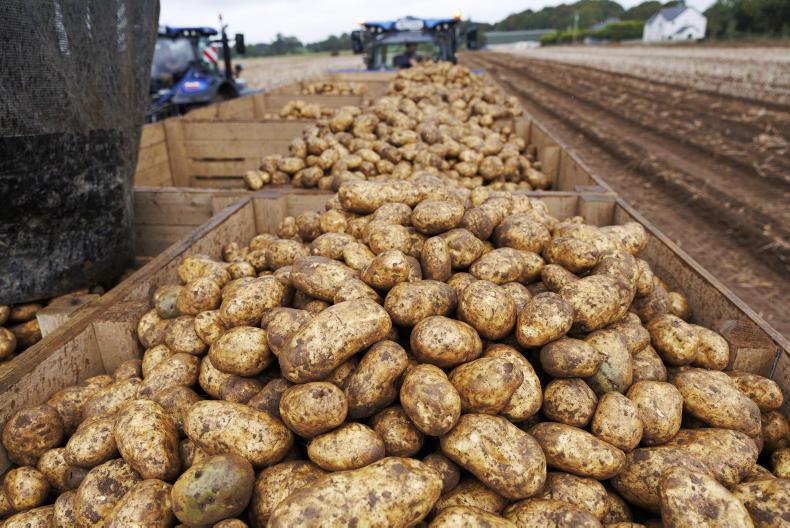
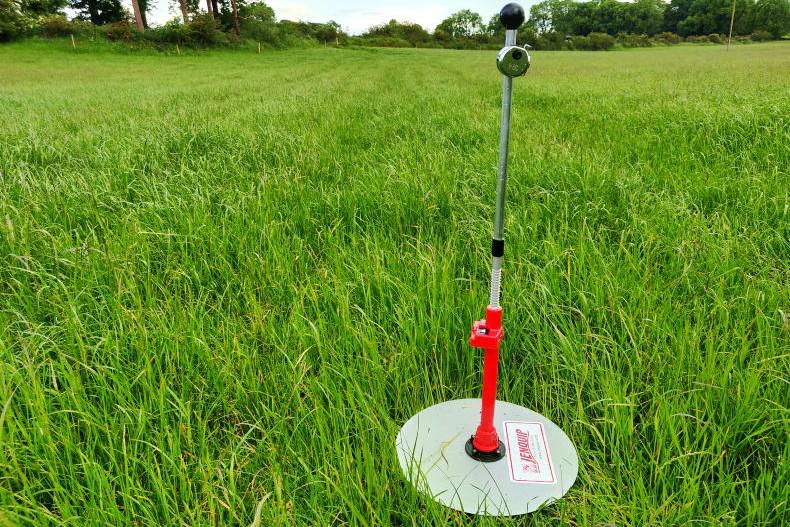
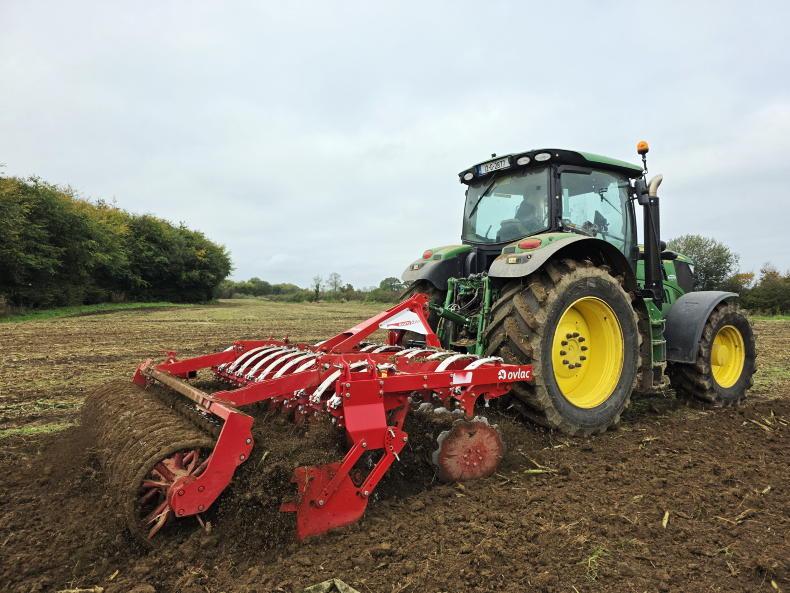

SHARING OPTIONS